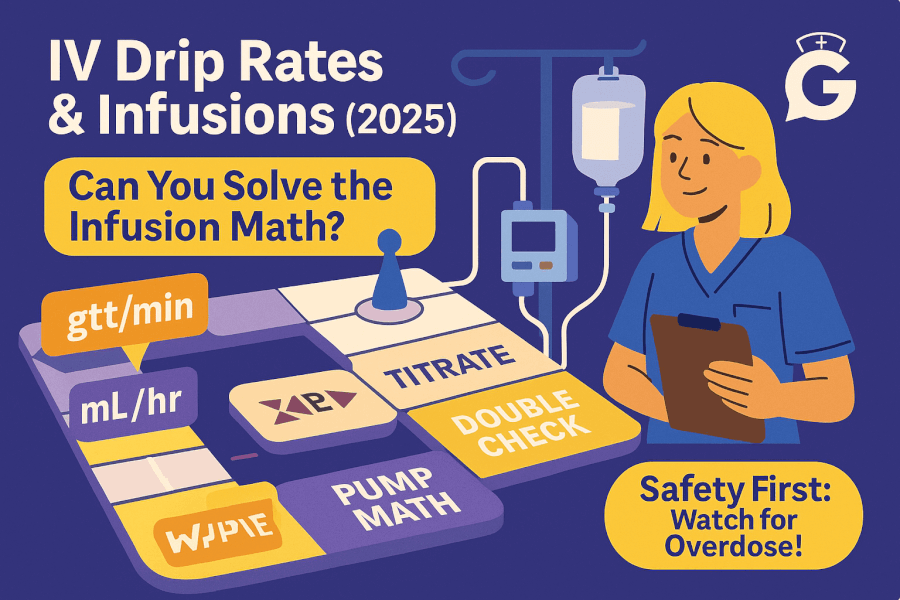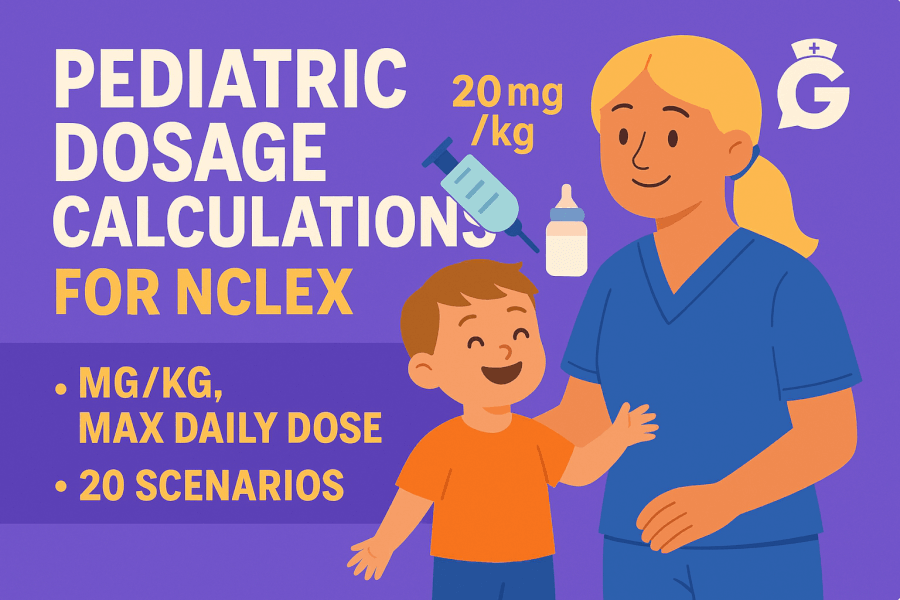Mastering Nursing Math Through Real-World Case Studies
Nursing math goes far beyond rote memorization of formulas—it’s about protecting patient safety and improving clinical decision-making. From calculating IV drip rates to converting doses for pediatric patients, confidence with numbers translates directly into better outcomes. In this article, we’ll explore key nursing math skills, walk through a realistic case study, and provide sample questions you can practice. Along the way, we’ll reference detailed resources from GoodNurse to reinforce your learning.
🎯 Free NCLEX quiz on this topic!
Test your knowledge after you finish reading.
Table of Contents
- Why Nursing Math Matters
- Core Formulas & Techniques
- Case Study: Mrs. Johnson’s IV Medication Dilemma
- Practice Questions & Step-by-Step Solutions
- Cross-Reference: Advanced Dosage Calculations
- Conclusion
Why Nursing Math Matters
- Patient Safety: A minor slip in decimal placement can lead to serious drug dosing errors.
- Critical Thinking: Accurate calculations inform vital decisions about medication timing, volume, and rate.
- Exam Readiness: Both NCLEX and HESI often feature dosage math. Mastery can boost your overall score and reduce test anxiety.
If you’re new to dosage calculations, be sure to explore the in-depth “Nursing Dosage Calculations: A Comprehensive Guide” on GoodNurse for step-by-step explanations and more practice problems.
Core Formulas & Techniques
-
Basic Formula for Oral & Injectable Doses
Desired Dose (D) / On-Hand Dose (H) × Quantity (Q) = Amount to Administer -
Weight-Based Dosing
(Ordered mg/kg) × (Patient Weight in kg) = Total mg per dose -
IV Flow Rate
(Volume to Infuse (mL) × Drip Factor (gtt/mL)) / Time (minutes) = gtt/min -
IV Infusion Pump Rate
Volume (mL) / Time (hours) = mL/hour
Case Study: Mrs. Johnson’s IV Medication Dilemma
Patient Profile
- Name: Mrs. Sarah Johnson
- Age: 67 years old
- Weight: 70 kg (154 lb)
- Admitting Diagnosis: Congestive Heart Failure (CHF) exacerbation
- Allergies: None reported
Clinical Scenario
Mrs. Johnson has been prescribed an IV medication (Furosemide) to manage fluid overload. She is showing signs of pulmonary edema and an elevated respiratory rate. The provider orders an IV bolus of Furosemide to relieve fluid retention, followed by a continuous IV infusion.
🥇Voted #1 Nursing Study Tool.
Personalized AI Tutor + Instant Answers to All Your Questions. 100% Money Back Guarantee!
- Bolus Order: 40 mg IV push, on-hand furosemide is 10 mg/mL.
- Maintenance IV Infusion: 10 mg/hour of furosemide in 100 mL of normal saline to run over 4 hours.
Nurse’s Task
- Calculate the volume needed for the bolus.
- Set the IV pump rate for the continuous infusion.
Practice Questions & Step-by-Step Solutions
1. Bolus Dose Calculation
Order: 40 mg IV push of furosemide
On-Hand: 10 mg/mL
Question: How many mL should the nurse draw up for the 40 mg dose?
Solution:
D / H × Q = (40 mg) / (10 mg/mL) × 1 mL = 4 mL
Answer: 4 mL of furosemide solution.
2. Maintenance IV Infusion Rate
Order: 10 mg/hour of furosemide for 4 hours in 100 mL total volume
Concentration: 40 mg of furosemide in 100 mL (since 10 mg/hr × 4 hrs = 40 mg total)
Question: What should the nurse set on the IV pump (in mL/hr)?
Solution:
mL/hour = Total Volume (mL) / Total Time (hours) = 100 mL / 4 hours = 25 mL/hour
Answer: 25 mL/hour on the IV infusion pump.
3. Weight-Based Calculation (Bonus Example)
Order: 1 mg/kg of a medication for a 70 kg patient. The on-hand solution is 20 mg/mL.
Question: How many mL will you administer?
Solution:
(1 mg/kg × 70 kg) = 70 mg total
D / H × Q = (70 mg) / (20 mg/mL) × 1 mL = 3.5 mL
Answer: 3.5 mL
Cross-Reference: Advanced Dosage Calculations
For more complex examples—like pediatric dosing, drip factor variations, and multiple-step math—check out our article “Nursing Dosage Calculations: A Comprehensive Guide” on GoodNurse. It provides additional practice sets, explanations, and helpful mnemonics to memorize common conversions.
You can also explore the GoodNurse AI Q&A if you get stuck on any advanced scenario—simply type your question and receive instant, detailed explanations.
Conclusion
Nursing math proficiency is more than just passing an exam; it’s integral to delivering safe and competent care. By practicing real-world calculations—like those in Mrs. Johnson’s case study—you build the confidence and accuracy needed on the clinical floor. Remember:
- Review core formulas regularly.
- Practice with case scenarios and test questions.
- Leverage resources like GoodNurse for on-demand Q&A and comprehensive dosage calculation guides.
With consistent effort and the right tools, you’ll master nursing math and be well-prepared for NCLEX, HESI, and everyday clinical practice.
Disclaimer: This article is for educational purposes only. Always adhere to your facility’s protocols and consult up-to-date clinical references. Follow your nursing program guidelines for exact calculation methods and safe medication administration.







